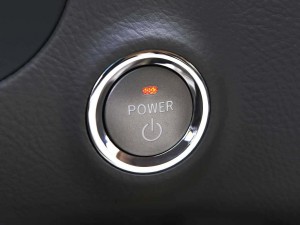
A prototype system used to detect drunk drivers might eventually be small and cheap enough to be built into a car's Start button.
Imagine a sensor small enough to slip inside of your car’s Start button that could be used to keep drunk drivers off the road.
That’s the goal of a multi-million-dollar project teaming supplier Detroit automotive supplier Takata and TruTouch, of Albuquerque, New Mexico. With help from the Automotive Coalition for Automotive Safety, or ACTS, they’re hoping to take the concept and put it into production.
Drunk driving is a scourge of the highway, and while intensive enforcement has helped drive down the numbers drivers over the legal limit are still responsible for nearly a third of all U.S. motor vehicle fatalities – about 11,000 in 2010.
The challenge is to either convince drivers not to drink and drive or to actively prevent them from doing so. Takata and TruTouch have come up with a device that could do just that. Rather than awkward breathalyzers that require a user to blow into a tube, or a truly invasive blood test, their prototype system uses an infrared sensor.
The National Highway Traffic Safety Administration, which has partnered with ACTS to address the drunk driving dilemma, said in a statement, the prototype system, “is seen as a potential tool for keeping drunk drivers from being able to operate their car if their blood-alcohol concentration is at or above the legal intoxication limit (.08 or higher). The technology could be voluntarily installed as an option for new cars and signal a new frontier in the fight against drunk driving.”
The $2.25 million grant from ACTS is aimed at overcoming a few critical problems that must be resolved to make the alcohol sensor viable. For one thing, the initial design is the size of a breadbox. The goal, a senior Takata official told the Detroit Free Press, is to shrink it down so it would be small enough to mount inside of a vehicle’s Start button.
It also needs to work faster – completing its analysis in a fraction of a second – and operate during all weather conditions, from a hot summer day in Phoenix to the coldest night in International Falls, Minnesota.
There’s also the issue of making sure that the person pressing the Start button – and being checked by the sensor – is actually the one who will be driving the car.
Ultimately, cost would have to come down, the partners estimate, to less than $200 per sensor.
Considering the way consumer electronics have pioneered the downsizing – and down pricing – of advanced technology, those familiar with the project say those targets are do-able, though it could take a decade to bring a viable version of the system to market.
The question is what would happen then? Would federal regulators require the technology in every new vehicle or only mandate its use for motorists with a previous alcohol-related conviction? The former approach might run afoul of civil liberty issues, though the courts have proven surprisingly tolerant, in recent years, of efforts to rein in drunk drivers.
